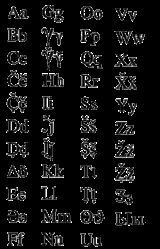
Wakhi language
Overview
Wakhi is an Indo-European language in the branch of Eastern Iranian
language family and is intimately related to other Southeastern Iranian languages in the Pamir languages
group.
Wakhi is one of several languages that belong to the Pamir language group
. A reflection of this is the fact that the Wakhi people
are occasionally called Pamiris
. The origin of this language is Wakhan
in Afghanistan
and is, according to sources, more than four thousand years old.
Eastern Iranian languages
The Eastern Iranian languages are a subgroup of the Iranian languages emerging in Middle Iranian times .The Avestan language is often classified as early Eastern Iranian. The largest living Eastern Iranian language is Pashto, with some 50 million speakers between the Hindu Kush mountains in...
language family and is intimately related to other Southeastern Iranian languages in the Pamir languages
Pamir languages
The Pamir languages are a group of the Eastern Iranian languages, spoken by numerous people in the Pamir Mountains, primarily along the Panj River and its tributaries. This includes the Badakhshan Province of northeastern Afghanistan and the Gorno-Badakhshan Autonomous Province of eastern Tajikistan...
group.
Wakhi is one of several languages that belong to the Pamir language group
Pamir languages
The Pamir languages are a group of the Eastern Iranian languages, spoken by numerous people in the Pamir Mountains, primarily along the Panj River and its tributaries. This includes the Badakhshan Province of northeastern Afghanistan and the Gorno-Badakhshan Autonomous Province of eastern Tajikistan...
. A reflection of this is the fact that the Wakhi people
Wakhi people
The Wakhi people, or Khik , are an ethnic group originating in the Wakhan of today's Afghanistan. They also live in adjacent areas of Tajikistan and Xinjiang and in Pakistan . They speak the Wakhi language.-Population and demographics:A very rough estimate puts the population of Wakhis at about...
are occasionally called Pamiris
Pamiri people
Pamiri is the name of an Iranian ethnic group in the Gorno-Badakhshan Autonomous Province in Tajikistan.-Ethnic Identity:The Pamiris are composed of people who speak the Pamiri languages, the indigenous language in the Gorno-Badakhshan autonomous province, and adhere to the Ismaili sect of Shia...
. The origin of this language is Wakhan
Wakhan
Wakhan or "the Wakhan" is a very mountainous and rugged part of the Pamir and Karakoram regions of Afghanistan. Wakhan District is a district in Badakshan Province.-Geography:...
in Afghanistan
Afghanistan
Afghanistan , officially the Islamic Republic of Afghanistan, is a landlocked country located in the centre of Asia, forming South Asia, Central Asia and the Middle East. With a population of about 29 million, it has an area of , making it the 42nd most populous and 41st largest nation in the world...
and is, according to sources, more than four thousand years old.
Unanswered Questions

